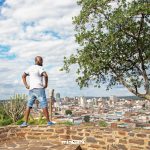1. Take your time
Working in low light requires a more considered approach to photography. It makes you work slower, because you usually need a tripod and the long exposure takes time. You have to be really careful and selective about what I photograph, but at the same time, working slower means I pay more attention to details.
Most photographers use their experience with low-light photography to capture their images using manual exposures. Situations in which combining artificial and natural light are the most difficult to get right. The balance of light intensity is always a challenge when photographing in low light. Artificial light is always brighter than natural light in these conditions, so there’s this very fragile balance to keep.
2. Use reflectors and LEDs to enhance natural light
Use a variety of light sources to create atmosphere in your photography. Sometimes use artificial light, including tungsten light and hand-held torches, but ideally prefer natural sources. Use Natural light rather than artificial light because then the act of taking a picture becomes an experience rather than my own construct.
In certain low-light situations, particularly when shooting portraits indoors, it is useful to use reflectors to bounce some extra light onto your subject. Always carry reflectors with you. If you are working in an interior environment, try and leave the items in place for sometime to observe how light behaves in the space.
When on a shoot, also carries small LED lights, which you can puts in a white plastic bag and places in a scene for some subtle extra illumination. Never use the LEDs as a main light – use them to ensure you I don’t lose information in the shadows. The light is very soft and almost invisible, but it does count in the final pictures.
3. Expand your options with the latest technology
Its recommended for one to use EOS 5D Mark IV) and Canon EOS 5DS R. or the recently released mirrorless Canon EOS R5, which has expanded the variety of low-light images one can shoot.
The EOS R5 changes everything, really, in terms of low light. It has such amazing image stabilisation and high ISO performance that you don’t need a tripod in some situations. It’s really liberating, because it gives one more chances to capture fleeting moments, rather than always being restricted to carefully setting up your camera. Its advisable to pair the EOS R5 with the Canon RF 24-70mm F2.8L IS USM lens, but also the RF 70-200mm F2.8L IS USM. The wide apertures on these lenses, together with 5-stop optical image stabilisation, are an important benefit when working in dimly lit conditions.
Sharpness is particularly important especially if you will prints the images at large sizes for exhibitions. “Previously, if you were hand-holding and shooting at slower than 1/125 sec I’d be worried about camera shake,” she says. “But now with the EOS R5 I can go slower and my images are still sharp. If you print big, don’t go over ISO4000, though that’s playing it safe – the EOS R5 can easily handle higher ISOs for editorial work or smaller prints.
4. Allow yourself to be surprised
When you’re shooting in near-darkness, what you see with your eyes and what the camera’s sensor records can be quite different, the unpredictability of the results is part of the magic of low-light photography. Sometimes you can see what looks like an amazing picture with your naked eye, then you take the shot and it doesn’t work. At other times, it’s pitch dark and you’re shooting into the space and hoping something will come out, and when you see the image it’s beautiful. I’m amazed every time I take a picture with a long exposure and the camera captures something I didn’t see – it’s so exciting. It’s like the camera is a kind of magic wand that helps me capture things that are invisible.
5. Enhance details in post-production
Most of your work should be achieve with the camera, but once done use use post production softwares e.g. Adobe® Photoshop® to bring out additional shadow details and tone down highlights where necessary.
Also play with colour temperatures and tones and try to give a consistent colour atmosphere to a series. “It’s always a tricky balance – how do you stay truthful to colours the camera saw in the dark, and how do you interpret them when you work on the image.
Often the original colours that the camera captures, even if they’re not completely accurate to you perceived, they will give you clues about how to build the tonalities in other pictures. In post-production your work is just to help those colours to shine more, rather than make them something else.
6. Be persistent and keep an open mind
Shooting in low light and creating well-exposed and aesthetically pleasing images is a skill that takes time to develop. Photographers working in low light need to have patience, not getting frustrated with technicalities and just keep trying. If you’re in difficult conditions and it’s cold and dark, it’s easy to give up. But low-light photography requires experimentation and really taking time with your camera. Remain open to anything invisible that becomes visible to you. The camera picks up some very subtle things that add to the images’ atmosphere. Then, when you see your images on a computer monitor or in large prints, it’s just such a fulfilling experience.



